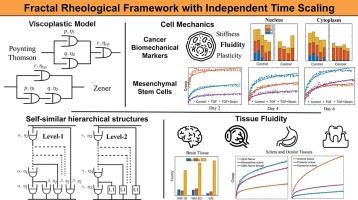基于分形演算的软生物物质统一流变模型
IF 7.9
2区 材料科学
Q1 MATERIALS SCIENCE, MULTIDISCIPLINARY
引用次数: 0
摘要
由于软生物物质复杂的多尺度非线性力学行为,在其多尺度结构中表现出独特的幂律特征,因此建模一直是一个长期关注的领域。分数粘弹性已被广泛用于捕捉其复杂的特性,但需要不同的模型来描述固体和流体的行为。在这项研究中,我们采用分形微积分,一个局部替代整体分数微积分,降低了数学和计算复杂性,开发分形流变粘塑性模型具有独立的时间尺度的本构分形元素。广义分形模型可以捕获固体和流体粘弹性模型之间的整个物理行为谱,同时具有时域解,不像分数阶模型。所提出的分形粘弹性自相似分层结构允许增加其局部和全局幂律行为的多尺度建模的可调性。由于生物物质的力学特性与疾病进展密切相关,开发的分形框架为其流变建模、分析和跨尺度模拟提供了统一的方法。从采用刚度、流动性和其他粘塑性参数作为癌症生物标志物,到为各种软生物物质提供材料流动性、粘弹性和塑性相互作用的详细见解,所提出的框架的多功能性已经建立起来。本文章由计算机程序翻译,如有差异,请以英文原文为准。

Unified rheological modeling using fractal calculus for soft biological matter
Modeling soft biological matter has been a long-standing domain of interest due to its complex, multiscale nonlinear mechanical behavior, exhibiting unique power-law characteristics within its multiscale architecture. Fractional viscoelasticity has been widely used to capture its intricate characteristics but requires different models to describe solid- and fluid-like behavior. In this study, we employ fractal calculus, a local alternative to global fractional calculus with reduced mathematical and computational complexity, to develop fractal rheological viscoplastic models with independent time scaling for constitutive fractal elements. Generalized fractal models can capture the entire spectrum of physical behavior between solid- and fluid-like viscoelastic models, while having time-domain solutions, unlike their fractional counterparts. The proposed fractal viscoelastic self-similar hierarchical structures allow increased tunability of their local and global power-law behavior for multiscale modeling. With the mechanical characteristics of biological matter strongly associated with disease progression, the developed fractal framework provides a unified methodology for their rheological modeling, analysis, and simulation across the scales. From employing stiffness, fluidity, and other viscoplastic parameters as cancer biomarkers to providing detailed insights into the interplay of material fluidity, viscoelasticity, and plasticity for a wide variety of soft biological matter, the versatility of the proposed framework is established.
求助全文
通过发布文献求助,成功后即可免费获取论文全文。
去求助
来源期刊

Materials & Design
Engineering-Mechanical Engineering
CiteScore
14.30
自引率
7.10%
发文量
1028
审稿时长
85 days
期刊介绍:
Materials and Design is a multi-disciplinary journal that publishes original research reports, review articles, and express communications. The journal focuses on studying the structure and properties of inorganic and organic materials, advancements in synthesis, processing, characterization, and testing, the design of materials and engineering systems, and their applications in technology. It aims to bring together various aspects of materials science, engineering, physics, and chemistry.
The journal explores themes ranging from materials to design and aims to reveal the connections between natural and artificial materials, as well as experiment and modeling. Manuscripts submitted to Materials and Design should contain elements of discovery and surprise, as they often contribute new insights into the architecture and function of matter.
 求助内容:
求助内容: 应助结果提醒方式:
应助结果提醒方式:


